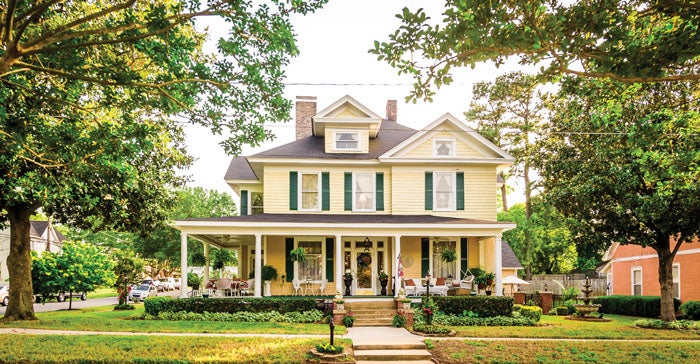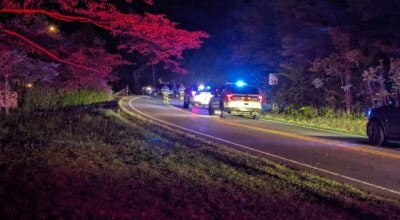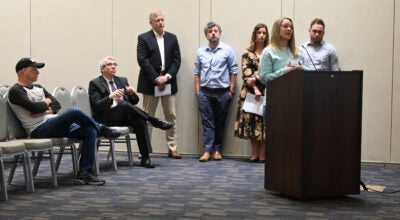Sites named for 2018 OctoberTour — it will have a Spencer flavor
Published 12:10 am Saturday, July 7, 2018

- The 1910 J.K. Dorsett House sits at 301 Fourth St., Spencer, at the corner of Rowan Avenue. It will be on this year's OctoberTour. Photo by Sean Meyers
Staff report
SALISBURY — Historic Salisbury Foundation announced Friday the 11 sites that will be on the 2018 edition of OctoberTour, which will be held Oct. 13-14.
As promised earlier, this year’s tour of historic properties will include several sites in Spencer, including the former Spencer Shops — today’s N.C. Transportation Museum.
In addition, OctoberTour will offer four Spencer houses.
Keeping with the Spencer focus, the food and entertainment usually offered on Salisbury’s West Bank Street in years past will instead take place at Spencer Library Park during tour hours.
Ticket holders and the public in general will be able to enjoy lunch, craft beer and wine, as well as live musicians at the park’s gazebo.
After tour hours on Saturday, Oct. 13, the Plein Air Artists reception and art show will be held on the park’s lawn where you can view and purchase works of art painted at sites throughout the tour.
The 2018 OctoberTour also will have an emphasis on the residential area of Salisbury’s North Main Street. Three North Main houses will be on the tour.
In downtown Salisbury, featured stops will be the 1908 Salisbury Station on Depot Street and two upstairs apartments on the Square — one at 101 S. Main St. (above Pottery 101) and the other, the third-floor apartment at 101 N. Main St. (above the 1859 Kluttz Drug Store).
Here’s a brief look at each OctoberTour site:
• 1896 Spencer Shops, Salisbury Avenue, Spencer — Spencer Shops, now home to the N.C. Transportation Museum, played an important role in the economy of Rowan County from its inception in 1896 through World War II. At its peak, the railroad shops employed between 2,000 and 2,500 people, many of whom lived in Spencer.
Purposely sited between Washington and Atlanta, Spencer Shops was Southern Railway Co.’s most important railroad repair facility until it was scaled back in the 1950s and fully closed in July 1960.
After becoming state property, the site opened its first exhibit as a transportation museum in 1983. It gradually restored buildings, including the impressive 37-stall Roundhouse. The newly renovated Back Shop won an HSF Preservation Award in 2017.
The museum will be on OctoberTour for the first time in 2018. Tour goers will be able to take a trolley ride through the facility and visit any or all of its exhibits.
• 1910 J.K. Dorsett House, 301 Fourth St., Spencer — Sitting on the corner of Fourth Street and Rowan Avenue across from the entrance to the Spencer Library, the J. K. Dorsett House is one of Spencer’s best known houses. The two-story frame house was built for banker J. K. Dorsett and his family.
Its dominant style is Queen Anne with a front gable and one-story porch wrapping around the Rowan Avenue side of the house. The house also has Colonial Revival features which include the Tuscan columns on the porch and a more simplified detailing than is typical of Queen Anne’s.
• 1909 Eagle-Burdette House, 409 Fourth St., Spencer — This two-story stucco house was built for W.M. Eagle, an engineer for Southern Railway who doubled as a financier for housing construction during Spencer’s early days. Eagle’s daughter, Annie Laurie, married T. R. Burdette, who worked for Southern and served as mayor of Spencer from 1953 through 1977. The Burdettes lived in the house through the 1980s.
A couple relocating from Australia purchased the house a year ago and are in the midst of an ongoing restoration project.
1910 McFee House, 509 S. Carolina Ave., Spencer — This house was given to the town of Spencer in June 2017 by John R. McFee, who had owned the property since 1968. The two-story frame house with a hip roof and cross gables has an undistinguished exterior. However, its historic interior remains largely intact with most wood trim, stairs and mantels remaining unpainted.
Spencer and the Salisbury Community Development Corporation formed a partnership to renovate the house. This unconventional arrangement will help Spencer return a vacant historic house to the market with all of the modern conveniences and restored historic charm. The renovation will be largely complete by OctoberTour.
• 1925 Snider-Floyd House, 505 Seventh St., Spencer — Robbie Snider, a fireman for Southern Railway, had this one-and-one-half story frame bungalow built in 1925. With its board and batten siding, the house has the overall feel of an English cottage.
Its dominant architectural features are of the bungalow style. Combinations of those two styles were popular during the 1920s and 1930s, as Spencer’s development matured and reached beyond the early town grid.
The house was renovated by the previous owners in 2010. Its current owners have continued to make improvements. They are avid collectors of eclectic art and antiques as well as memorabilia related to the house and the railroad.
• 1910 Davis-Wilhelm-McDaniel House, 910 N. Main St., Salisbury — This elaborate one-and-one-half story frame bungalow nicely illustrates the three architectural styles that characterize the early North Main Street houses. Its bungalow styling is evident from the house’s steep gable end roof with flared eaves, its front dormer and its contrasting stucco and shingled siding.
The Tuscan columns on the porch add a Colonial Revival touch to the house while the projecting bay is late Victorian. The interior reflects the same mix of styles. It was built by A.E. Davis around 1910.
By 1920, Adolphus Wilhelm, a bookkeeper for the railroad, and his wife, Minnie, owned it until the crash of 1929. Its current owner has added an artistic flair to the cottage.
• 1912 J.C. Cress House, 928 N. Main St., Salisbury — J.C. Cress built this two-story frame house and lived there with his family into the 1940s. The house nicely illustrates how a less fussy version of the Victorian style morphed into a Colonial Revival look.
Its overall composition, notably the projecting front gable and brackets, is distinctly Victorian. Yet, the simplicity of the styling and lack of ornamentation on the house looks similar to the four-square, a popular version of the Colonial Revival style in that era.
Historic Salisbury Foundation acquired the J. C. Cress House for the Revolving Fund in 1997, selling it to Ken Weaver and Preston Sale in 1998. The house has been renovated and sold several times since.
• 1926 F. N. McCubbins House, 1013 N. Main St., Salisbury — The four-square F.N. McCubbins House was influenced by the area’s bungalows, but it is predominately Colonial Revival in style and appearance. It was built around 1926 by F.N. McCubbins, a well-known local realtor and businessman, and was one of the first sites (three lots in total) sold and developed in the Steeleworth subdivision, located east of the mid-section of North Main Street.
The two-story frame house was severely damaged by fire in December 2016 and was donated to Historic Salisbury Foundation a year later for its revolving fund. The foundation is currently working to clear out the fire-damaged interior and to stabilize the exterior of the house. The McCubbins House, which should be on the market for sale by year end, is featured on OctoberTour as a “work in progress.”
• 1859 Kluttz Drug Store, third-floor apartment, 101 N. Main St., Salisbury — Dr. C.A. Henderson built and opened a drugstore on the northeast corner of Main Street in 1858. The three-and-one half story brick building, said to be the tallest in the state at the time, is one of the only pre-Civil War commercial buildings remaining in downtown Salisbury.
Henderson left Salisbury after the Civil War, and the drugstore was taken over by Theo. F. Kluttz. Later, the Purcell family bought the building and ran their drug store on the ground floor until the mid 1970s.
The building sat neglected for years. Margaret and George Kluttz along with Bill and Susan Kluttz bought it in 1985 and completed its restoration a few years later. One of the innovations was to convert the third floor, once home to a Masonic Temple, into a loft apartment. Recently remodeled, it was one of the first apartments in downtown Salisbury — well ahead of today’s trend in downtown living.
• 1873 Hedrick Block Building, apartment, 101 S. Main St., Salisbury — This commercial building was home to Littmann & Lichtenstein Dry Goods in its early days. The two-and-one-half story brick structure has arched windows on its front and south side.
It was first modernized in the 1920s with the addition of two false Spanish tile mansard roofs supported by decorative brackets. Much later its façade was covered with aluminum siding—“modernized,” along with many other storefronts in downtown Salisbury.
The building’s current owners acquired it in 2008; they painstakingly restored the façade and renovated the interior. It is now the home of Pottery 101 on the ground floor and an upstairs apartment for the owners. It includes a newly built roof terrace.
• 1908 Historic Salisbury Station, 215 Depot St., Salisbury — The Salisbury Railway Passenger Station, designed in the Spanish Mission style by noted architect Frank P. Milburn, makes its eighth appearance on OctoberTour. In 1984, Historic Salisbury Foundation acquired the station, then vacant and derelict after rail passenger service stopped in 1979.
The foundation raised funds from the local community and completed the renovation of the Station in 1993, 25 years ago. Today, the Salisbury Station receives more than 50,000 visitors a year and is notable for being a catalyst for the redevelopment of the surrounding neighborhood. It is a national landmark, recognized as one of Amtrak’s Great American Stations and has its own exhibit in the Smithsonian Museum.
This year, Salisbury Station will be the site of weekend ticket sale pick-ups and will be open as a tour site to railroad buffs. Tickets will be available at the window of the original ticket office.
• Other tour activities: On Thursday night, Oct. 11, the annual Patrons’ Party will provide HSF patrons, sponsors and homeowners with a night of food, drink and dancing.
This year’s Patron’s Porch, set aside during tour hours for participating homeowners, patrons and sponsors, will be hosted by Trustee Emerita Sarah Kellogg.
On Friday, Oct. 12, Catawba College professor Dr. Gary Freeze will be the guest speaker at HSF’s “Lunch and Learn” session. His talk, “Towns, Trains and Transition: 1839-1913,” will explore the impact of the railroad on this area.
The Lunch and Learn will include a field trip to the N.C. Transportation Museum for an early view of historic private railcars.
For detailed tour information, sponsorship opportunities, photos of the sites and to purchase tickets, visit www.octobertour.com.




